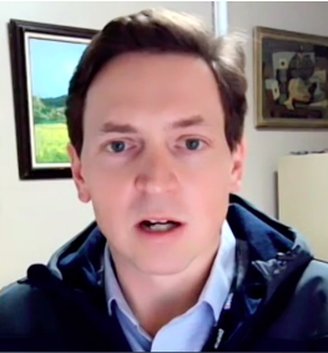
Humboldt was placed in the red tier on Feb. 23. | Image via covid19.ca.gov.
###
The pandemic is finally easing up a bit.

Hoffman
Humboldt County’s rates of confirmed COVID-19 cases and hospitalizations have dropped and stabilized enough that even if the state wants to return us to the more-restrictive purple tier of public health regulations, county staff will protest the decision, allowing us to remain in the red tier for at least the coming week, Public Health Officer Dr. Ian Hoffman said at Tuesday’s Board of Supervisors meeting.
Governor Gavin Newsom is scheduled to provide the latest update on county tier designations at noon Tuesday. Based on local data, the state on Feb. 23 lowered Humboldt County from the most-restrictive purple tier to the red tier, allowing businesses, schools and organized sports a bit more freedom.
Hoffman said the county recently accumulated one week of epidemiological data sufficient to justify a return to the purple tier. That means we had more than seven new cases per 100,000 people and/or a test positivity rate above 8 percent. (Our adjusted case rate per 100,000 currently stands at 8.2 on the county dashboard.) But Hoffman and the rest of the county’s Public Health team don’t want to see the county “yoyo” between tiers when things seem stable, he said.
“So we’ve been communicating with the state of California, trying to make sure we advocate,” Hoffman continued. “We strongly feel that our metrics have reflected that our case rates are stable.”
As the latest COVID surge peaked locally in late January, the county’s case rate rose as high as 26 per 100,000 people. It has since stabilized to between six and 10 per 100,000. The hospitalization rate has also declined dramatically, from a high of more than 15 per day during the surge to single digits now.
“We have decided that if the state were to try to move us to purple we would ask for adjudication,” Hoffman told the board this morning, referring to the formal appeal process allowed under the state’s Blueprint for a Safer Economy. Through adjudication, counties can protest being moved to a more restrictive tier if public health staff believes the decision failed to account for data discrepancies or “qualitative and contextual elements.” During the adjudication process, the county’s tier status would remain unchanged.
“But we do want to recognize that this recovery is fragile,” Hoffman added, pointing out that we’re not far removed from the surge and new COVID-19 variants represent “a real threat.”
“So we’ll keep up that fight, and hopefully the state will make the right decision,” he said.
The situation in local hospitals has improved so much that the county plans to remove “ICU capacity” from its COVID dashboard.
More than eight percent of the county’s eligible population has now received at least one dose of vaccine, a figure Hoffman called “an amazing testament to the effort put forth in Humboldt County over the last few months.” And while progress continues to be hampered by limited availability of vaccines, Hoffman said the situation should improve in the coming months, especially as Johnson & Johnson’s single-dose vaccines gets wider distribution.
Last week the state announced that it would reserve 40 percent of its vaccine supply for the most vulnerable neighborhoods, a collection of 400 zip codes with lower levels of household income, education and access to health care. Humboldt County has 13 such zip codes, and Hoffman said we should learn this week how that will affect our vaccine supplies.
“It feels like we’re at a point of really palpable change with this pandemic,” he said, adding that with case rates falling we can finally look forward to “some return to normalcy.”
But he also cautioned against letting our guard down, saying, “In the end, the things that got us to where we are today will still be the cornerstone” — namely masking, social distancing, washing our hands and avoiding gatherings with multiple households.
The county is now encouraging all residents age 65 and older to contact the Joint Information Center at (707) 441-5000 with any questions about how to get in line for a vaccine.
Hoffman said we’re getting “much, much closer” the the point where everyone who wants a vaccine can get one. That much-desired time is “likely only a few months away,” he said.
CLICK TO MANAGE